当前位置:
X-MOL 学术
›
Am. J. Primatol.
›
论文详情
Our official English website, www.x-mol.net, welcomes your
feedback! (Note: you will need to create a separate account there.)
Infrared thermography cannot be used to approximate core body temperature in wild primates
American Journal of Primatology ( IF 2.0 ) Pub Date : 2020-10-11 , DOI: 10.1002/ajp.23204 Richard McFarland 1, 2 , Louise Barrett 2, 3 , Andrea Fuller 2 , Robyn S. Hetem 2, 4 , Warren P. Porter 5 , Christopher Young 6, 7 , S. Peter Henzi 3, 6
American Journal of Primatology ( IF 2.0 ) Pub Date : 2020-10-11 , DOI: 10.1002/ajp.23204 Richard McFarland 1, 2 , Louise Barrett 2, 3 , Andrea Fuller 2 , Robyn S. Hetem 2, 4 , Warren P. Porter 5 , Christopher Young 6, 7 , S. Peter Henzi 3, 6
Affiliation

|
Understanding the physiological processes that underpin primate performance is key if we are to assess how a primate might respond when navigating new and changing environments. Given the connection between a mammal's ability to thermoregulate and the changing demands of its thermal environment, increasing attention is being devoted to the study of thermoregulatory processes as a means to assess primate performance. Infrared thermography can be used to record the body surface temperatures of free‐ranging animals. However, some uncertainty remains as to how these measurements can be used to approximate core body temperature. Here, we use data collected from wild vervet monkeys (Chlorocebus pygerythrus) to examine the relationship between infrared body surface temperature, core body (intra‐abdominal) temperature, and local climate, to determine to what extent surface temperatures reflect core body temperature. While we report a positive association between surface and core body temperature—a finding that has previously been used to justify the use of surface temperature measurements as a proxy for core temperature regulation—when we controlled for the effect of the local climate in our analyses, this relationship was no longer observed. That is, body surface temperatures were solely predicted by local climate, and not core body temperatures, suggesting that surface temperatures tell us more about the environment a primate is in, and less about the thermal status of its body core in that environment. Despite the advantages of a noninvasive means to detect and record animal temperatures, infrared thermography alone cannot be used to approximate core body temperature in wild primates.
中文翻译:

红外热成像不能用于估计野生灵长类动物的核心体温
如果我们要评估灵长类动物在新的不断变化的环境中航行时的反应方式,那么了解支撑灵长类动物行为的生理过程至关重要。鉴于哺乳动物的温度调节能力与其不断变化的热环境需求之间存在联系,因此越来越多地致力于研究温度调节过程,以评估灵长类动物的行为。红外热像仪可用于记录散养动物的体表温度。但是,如何将这些测量值用于近似核心体温仍存在一些不确定性。在这里,我们使用从野生黑长尾猴(Chlorocebus pygerythrus)检查红外体表温度,核心体(腹内)温度和当地气候之间的关系,以确定表面温度在多大程度上反映了核心体温度。虽然我们报告了地表温度与核心体温之间的正相关关系(先前已被用来证明使用表面温度测量值作为核心温度调节的代表),但当我们在分析中控制了局部气候的影响时,不再观察到这种关系。也就是说,体表温度仅由当地气候预测,而不是由核心体温预测,这表明表面温度告诉我们有关灵长类动物所处环境的更多信息,而较少告诉我们其在该环境中体核的热状态。
更新日期:2020-11-19
中文翻译:

红外热成像不能用于估计野生灵长类动物的核心体温
如果我们要评估灵长类动物在新的不断变化的环境中航行时的反应方式,那么了解支撑灵长类动物行为的生理过程至关重要。鉴于哺乳动物的温度调节能力与其不断变化的热环境需求之间存在联系,因此越来越多地致力于研究温度调节过程,以评估灵长类动物的行为。红外热像仪可用于记录散养动物的体表温度。但是,如何将这些测量值用于近似核心体温仍存在一些不确定性。在这里,我们使用从野生黑长尾猴(Chlorocebus pygerythrus)检查红外体表温度,核心体(腹内)温度和当地气候之间的关系,以确定表面温度在多大程度上反映了核心体温度。虽然我们报告了地表温度与核心体温之间的正相关关系(先前已被用来证明使用表面温度测量值作为核心温度调节的代表),但当我们在分析中控制了局部气候的影响时,不再观察到这种关系。也就是说,体表温度仅由当地气候预测,而不是由核心体温预测,这表明表面温度告诉我们有关灵长类动物所处环境的更多信息,而较少告诉我们其在该环境中体核的热状态。











































 京公网安备 11010802027423号
京公网安备 11010802027423号